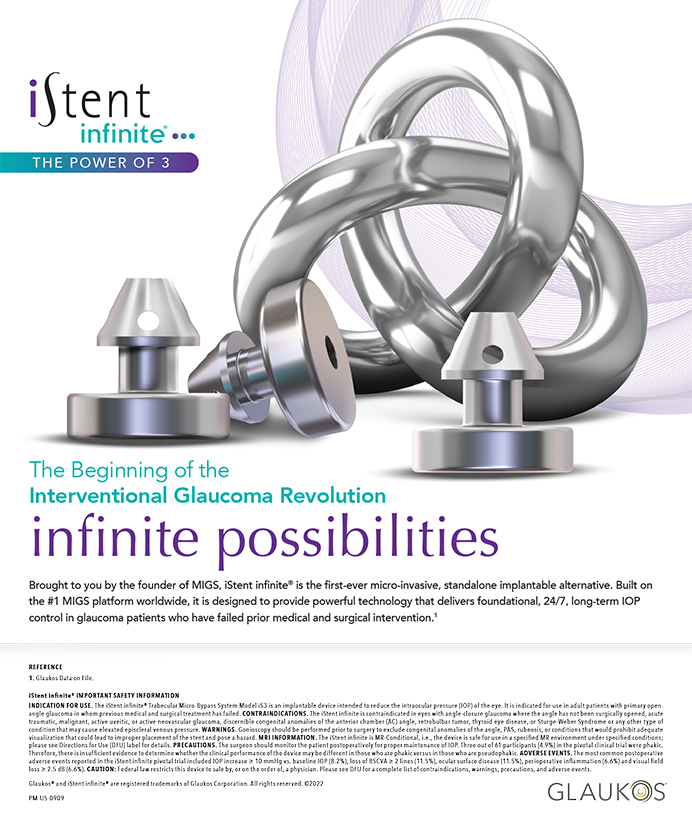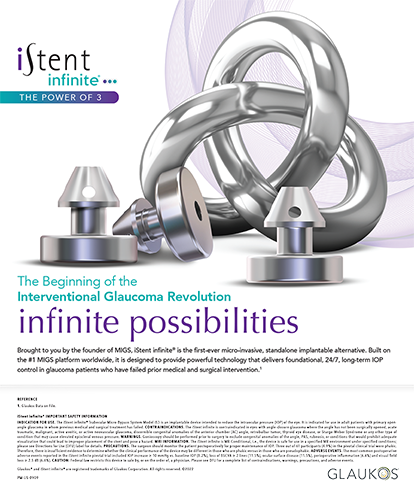Few options are available for the surgical correction of presbyopia in precataract patients. Refractive lens exchange with the implantation of an IOL is performed in only 5% of these patients in the United States because of the problems associated with intraocular surgery.1 Corneal presbyopic treatments are viable options for young presbyopes (between 40 and 55 years of age), with corneal inlays and excimer laser surgery the two most common extraocular surgeries for presbyopia. Scleral bands and conductive keratoplasty are disappearing from the ophthalmic world.
INCREASING DEPTH OF FOCUS
Corneal aberrations, namely spherical aberration and coma, increase depth of focus and therefore improve presbyopia. 2 A combination of positive and negative spherical aberrations or two negative spherical aberrations increases depth of focus. Multifocal IOLs and corneal inlays are designed to combine spherical aberrations in these ways (Figures 1-3).
PresbyLASIK is the name given to the surgical correction of presbyopia with an excimer laser ablation. It includes all types of excimer surgery, from surface ablation to femtosecond laser-assisted LASIK. This corneal procedure either creates a central zone for near vision (central presbyLASIK) or leaves the central zone for distance vision and creates a peripheral zone for near vision (peripheral presbyLASIK). The difference between the two methods is the spherical aberration they produce. A central ablation creates a negative spherical aberration in the center of the cornea (Z40) and a positive spherical aberration in the periphery (Z60). A peripheral ablation creates a central positive spherical aberration (Z40) and a negative spherical aberration (Z60). In both cases, the presence of these two aberrations increases depth of focus and improves near vision, reducing patients' dependence on spectacles.
EXPERIENCE WITH PresbyLASIK
For 3 years, we observed 121 eyes (66 patients; mean age, 51 years; range, 41-67 years) that underwent presby- LASIK (unpublished data). The mean preoperative sphere was 0.18 D ±2.20 (-5.00 to +5.00 D), and the mean preoperative cylinder was -0.74 D ±0.97 (-6.50 to 0.00 D). Of the 66 patients, 57.9% were hyperopic, 31.4% were myopic, and 10.7% were emmetropic. The majority of patients (86.8%) underwent LASIK with a femtosecond laser or microkeratome for the creation of the flap. Three months postoperatively, the retreatment rate was 9.9%.
Three years postoperatively (mean), 94% of eyes had an uncorrected distance visual acuity of 20/30 or better, and 95% of eyes had an uncorrected near visual acuity of 20/25 or better. All eyes achieved a near and distance BCVA of 20/25, and none of the eyes lost lines of BCVA. When analyzed by refractive defect, myopes had better near and distance vision after presbyLASIK compared with hyperopes. Hyperopia involves an increase in corneal curvature, which produces less quality of vision compared with the applanation induced by the laser for myopic corrections. Ninety-two percent of patients are 100% spectacle independent, 3.2% do not drive at night due to visual symptoms, and 100% of patients said they would recommend the surgery to a friend.
PROS AND CONS
As an extraocular surgery with no sight-threatening complications, presbyLASIK offers several advantages. LASIK is a well-known procedure to most ophthalmologists, and as such, the technology is easily accessible. The laser's software is different, but the surgical techniques are similar to those used in other excimer laser-based procedures. The complication rate for LASIK in general and the complications associated with the procedure include dry eye and displacement of the flap.3 Striae and over- or undercorrection are easily managed in the postoperative period. Additionally, refractive errors can be corrected with the excimer laser at the time of an excimer ablation, and the surgery is reversible with CustomVue wavefront-guided treatments (Abbott Medical Optics Inc.).
A disadvantage of presbyLASIK is that it is a temporary solution (mean, 5 years), which can be repeated. Although there is some concern about the future development of a cataract, luckily, with new topography software and formulas, cataract surgery is not a problem in eyes that have previously undergone presbyLASIK. In our experience, visual symptoms such as those associated with multifocal IOLs can occur, but they are less severe and usually are not permanent. A decrease in contrast sensitivity is common after presbyLASIK, but, based on my experience, contrast vision returns to normal between 3 and 6 months postoperatively.
CONCLUSION
PresbyLASIK is a viable option for the correction of presbyopia, particularly for young presbyopes. In our opinion, the procedure's advantages outweigh its disadvantages, because the modality offers improved quality of life to a large patient population.
Gustavo Tamayo, MD, is the director of the Bogotá Laser Refractive Institute in Bogotá, Colombia. He is a consultant to Abbott Medical Optics Inc. and Presbia, and he holds a patent for a method of presbyopic excimer laser ablation. Dr. Tamayo may be reached at gtvotmy@telecorp.net.
Claudia Castell, MD, is an attending ophthalmologist at the Bogotá Laser Refractive Institute in Bogotá, Colombia. She acknowledged no financial interest in the products or companies mentioned herein. Dr. Castell may be reached at claudiacastell@yahoo.com.
Pilar Vargas, MD, is an attending ophthalmologist at the Bogotá Laser Refractive Institute in Bogotá, Colombia. She acknowledged no financial interest in the products or companies mentioned herein. Dr. Vargas may be reached at pilar_vargas@hotmail.com.
- Duffey RJ, Leaming D. US trends in refractive surgery:2010 ISRS Survey. Paper presented at: The AAO Annual Meeting; October, 2010;Chicago, IL.
- Rocha KM, Vabre L, Chateau N, Krueger RR. Expanding depth of focus by modifying higher-order aberrations induced by an adaptive optics visual simulator. J Cataract Refract Surg. 2009;35(11):1885-1892.
- Melki SA, Azar DT. LASIK complications: etiology, management, and prevention. Surv Ophthalmol. 2001;46(2):95-116.


